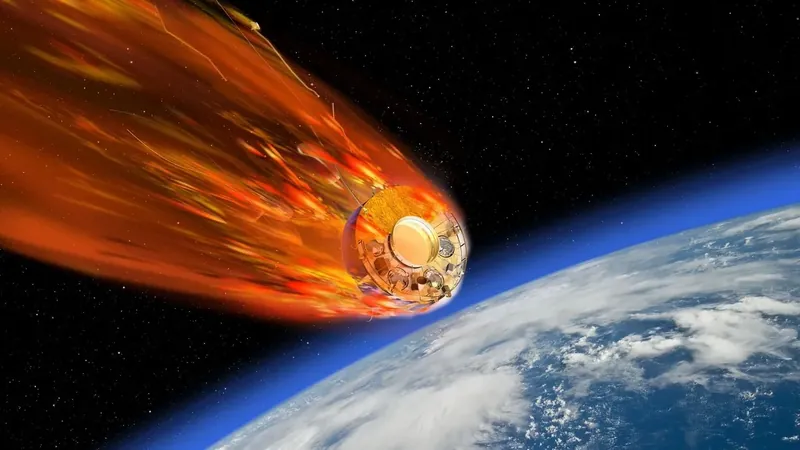
Earth's Atmosphere at Risk: Can In-Orbit Refueling Save Us from Satellite Pollution?
2025-06-03
Author: Jessica Wong
As global efforts ramp up to combat environmental degradation on Earth, the space industry continues to grapple with its own sustainability crisis. The shift towards megaconstellations has hastened the launch of disposable satellites, which are designed for brief lifespans, often just a few years. This trend raises significant concerns about the environmental repercussions of excessive aluminum and other materials burning up in the atmosphere.
Could the solution be a circular economy in space that emphasizes recycling and reusability? Advocates of in-orbit servicing and refueling believe this could be a game-changer. Yet, skepticism remains; analysts suggest that without stringent environmental regulations, satellite operators might be unwilling to transition to reusable technologies.
One pioneer in this field is Dave Barnhart, CEO of Arkysis. He has been developing recyclable satellite technology concepts for nearly two decades, with a focus on creating a satellite recycling facility in geostationary orbit, located 22,000 miles above Earth. His vision revolves around utilizing components from old satellites to construct new ones, maximizing the existing mass already in space.
Currently, Arkysis is shifting its focus to low Earth orbit (LEO), the bustling area just a few hundred miles above our planet, notorious for generating hazardous space debris. The company plans to establish an innovative service and refueling depot, dubbed the Port, aiming to revolutionize practices in this crowded domain.
"Historically, we've treated every satellite as a one-and-done mission," Barnhart lamented. "Yet everywhere else, we maintain, sustain, and grow our technology. It's insane we're not doing the same in space." In 2023, Arkysis received a $1.6 million contract from the U.S. Space Force to experiment with satellite assembly in orbit, launching the first piece of their modular depot soon.
The Port will include a main module set to be deployed in 2027, alongside a transport device known as the Cutter. This cutting-edge setup will not only serve as a fuel depot but also supply various components to rejuvenate aging satellites, extending their operational life significantly.
In a bid to transform the satellite lifecycle, new technologies could replace outdated cameras and antennas or swap out worn batteries. Although the concept appears promising, industry analysts like Dafni Christodoulopoulou caution about the costs of in-orbit maintenance. Many small, inexpensive satellites dominate LEO, making it cheaper for operators to replace them rather than service.
Barnhart acknowledges the resistance from satellite manufacturers, whose revenue relies heavily on producing new, disposable satellites. Yet, he envisions a future where integrating serviceable parts could breathe new life into existing technology.
Christodoulopoulou emphasizes that the future of satellite operations and orbital environments depends on the implementation of in-orbit services to manage debris and maintain sustainability. With the U.S. government backing Arkysis and supporting separate missions testing refueling technologies, the direction seems hopeful.
As geopolitical tensions escalate, the demand for swift deployment of new satellite capabilities increases. Barnhart believes servicing systems like the Port could meet these needs more quickly than building new hardware from scratch.
“New threats demand new solutions, and if we can enhance existing satellites with upgraded capabilities, we can respond faster,” he argued. Regulatory changes that promote environmentally conscious practices could further shift attitudes toward more sustainable operations in space.
Ultimately, the journey toward a space industry that respects environmental boundaries while advancing technology is in our hands. The question remains: are satellite operators ready to embrace a future of sustainability?






 Brasil (PT)
Brasil (PT)
 Canada (EN)
Canada (EN)
 Chile (ES)
Chile (ES)
 Česko (CS)
Česko (CS)
 대한민국 (KO)
대한민국 (KO)
 España (ES)
España (ES)
 France (FR)
France (FR)
 Hong Kong (EN)
Hong Kong (EN)
 Italia (IT)
Italia (IT)
 日本 (JA)
日本 (JA)
 Magyarország (HU)
Magyarország (HU)
 Norge (NO)
Norge (NO)
 Polska (PL)
Polska (PL)
 Schweiz (DE)
Schweiz (DE)
 Singapore (EN)
Singapore (EN)
 Sverige (SV)
Sverige (SV)
 Suomi (FI)
Suomi (FI)
 Türkiye (TR)
Türkiye (TR)
 الإمارات العربية المتحدة (AR)
الإمارات العربية المتحدة (AR)